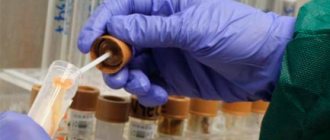Why is infection dangerous?
There are up to thirty species of staphylococcal bacteria, some of which live in the body without harming it.
The most dangerous are Staphylococcus aureus, saprophytic and epidermal staphylococci. The first affects absolutely any tissue and organs in people of any age. The microorganism can cause pneumonia, food poisoning, blood poisoning, meningitis and other dangerous diseases. If the test for Staphylococcus aureus is positive, the patient is immediately prescribed a course of antibiotics, but, unfortunately, this infection is difficult to treat; it is resistant to high temperatures, alcohol, and antibiotics.
In what cases is culture for Staphylococcus aureus usually prescribed?
Staphylococcus aureus is ubiquitous and is transmitted from person to person through contact, air, water and food. Capable of causing acute and chronic purulent processes in various organs. It can often colonize the mucous membranes of the ENT organs, gastrointestinal tract, and genitourinary system, causing a state of asymptomatic bacterial carriage. Once in the human body, it produces toxins that inhibit the functioning of the immune, nervous systems and gastrointestinal tract. It can become a source of sepsis when immunity is reduced, causing generalized infections with secondary foci of inflammation in the internal organs and the musculoskeletal system.
Staphylococcus aureus can cause food toxic infections when consuming foods contaminated with it and its toxin: uncooked confectionery (containing eggs and dairy products), salads and ice cream.
Children can become infected from adult staphylococcus carriers. In infants, staphylococcus may be isolated from stool cultures.
For epidemiological purposes, the analysis is carried out during annual preventive examinations and during preliminary examinations for employment in the public service sectors: medicine, education, nutrition and trade. In this case, seeding is performed from 2 loci: the nose and pharynx.
When is it necessary to get tested for staphylococcus?
In adults, alarming symptoms include frequent skin rashes, inflammation of the sweat and sebaceous glands. Even a common runny nose, which is difficult to cure, a cough and sore throat can indicate the activity of these bacteria and be a serious reason to take a nasal test for staphylococcus.
Symptoms depend on the location of the bacterium. May be affected:
- skin: purulent rashes;
- bones: pain when moving, swelling;
- digestive system: vomiting or nausea, fever, diarrhea;
- heart: murmurs;
- reproductive system: difficulty urinating, pulling sensations in the back;
- respiratory system: redness and sore throat, white coating.
At risk are pregnant women, for whom a blood test for staphylococcus and streptococcus is included in the list of mandatory tests; workers of medical institutions and catering establishments; patients with diabetes mellitus, HIV positive. The study is also carried out for skin injuries and cancer.
Infection can occur by airborne droplets, in everyday life, through biological fluids, or with food.
How does infection occur?
You can become infected either from a sick person who knows about his disease and is undergoing treatment, or from a carrier who does not suspect that his body is occupied by a dangerous infection.
According to WHO, approximately 30% of carriers are unaware that they are carriers of these bacteria. This once again confirms the fact that most of us would do well to get tested even when there are no obvious symptoms of any disease.
The infection reaches us through airborne droplets and airborne dust. It can penetrate through the skin and mucous membranes if there are microdamages on them. Staphylococcus especially often affects those who have weakened immune systems and who suffer from chronic diseases. The likelihood of dangerous consequences is also influenced by lifestyle and air pollution.
Types of analyzes
The decision on which study to refer the patient to is made by the attending physician, based on the symptoms and general picture of the disease. The most common blood test is for staphylococcus, but biomaterial is also taken from the throat, nose, ears, wounds, even breast milk is tested. A stool test for staphylococcus and a rectal smear are also informative.
The referral can be written by a general practitioner, ENT doctor, mammologist, dermatologist, gastroenterologist, immunologist and other specialists.
How to prepare for the analysis?
The material for analysis can be:
- swab their oropharynx
- sputum
- nasal passage/sinus swab
- tracheobronchial lavages
- breast milk.
- stool, rectal swab
For any localization, it is important to get tested before starting antibiotic therapy or 2 weeks after it ends!
- to take a swab from the oropharynx strictly on an empty stomach, before brushing your teeth!
- feces and breast milk in a sterile container without touching the edges with your hands. Each breast has its own container.
- Sputum is taken in the morning on an empty stomach after thoroughly brushing your teeth, rinsing your mouth with boiled water.
Tests for staphylococcus in children
In infants, a throat test for staphylococcus is taken during an inflammatory process in the larynx or pharynx. If your baby has diarrhea, a stool test for staphylococcus may be ordered. In newborns, the collection is made using a sterile film. Older children should undergo this study if they often suffer from bronchitis or pneumonia. In this case, sputum is given for culture. Rhinitis, sinusitis, and pharyngitis also make one suspect the activity of staphylococcus bacteria. In this case, the patient is tested for Staphylococcus aureus in the throat; the test is usually painless and does not cause serious difficulties.
Indications for testing for Staphylococcus aureus
Preventive examinations for Staphylococcus aureus
Staphylococcus aureus often does not manifest itself in any way, and the carrier does not even suspect that he is a carrier of this dangerous bacterium. Therefore, for workers in many fields, testing for staphylococcus is mandatory when undergoing medical examinations.
The analysis is also prescribed for preventive purposes to patients at risk , that is, those whose immunity is weakened and the likelihood of complications is increased (cancer patients, diabetics, pregnant women, elderly people, children).
Symptoms for which a test for staphylococcus is prescribed:
- skin rashes - boils, ulcers
- laryngitis, pharyngitis
- mastitis
- various lung lesions
- inflammatory process in joints and bone tissue
- frequent gastrointestinal diseases with symptoms of poisoning
- pain in the lumbar area
- pain when urinating
- symptoms of intoxication
- heart murmur
Analyzes at VERAMED
Why is it convenient for you to get tested with us? Because at VERAMED this can be done quickly, without queues and with the most reliable results, which can be achieved with high-quality reagents. We will conduct tests of any complexity, including testing for staphylococcus in a newborn child.
You can take any other tests at our medical centers in Odintsovo and Zvenigorod any day of the week. Additional information on the cost of services and preparation for the study can be obtained from the call center staff.
What diseases does the infection cause?
Staphylococci cause the development of purulent diseases of the skin and subcutaneous tissue, which lead to boils, abscesses, pyoderma - purulent skin lesions and hidradenitis - purulent inflammation of the sweat glands. It can also cause the development of pneumonia, sore throat, meningitis, osteomyelitis, endocarditis and abscesses of internal organs.
In addition, it can cause thrombophlebitis of the superficial veins of the brain, which leads to severe neurological diseases. During their life, cocci release dangerous toxins that can lead to severe intoxication, including a life-threatening disease - sepsis.
Culture for Staphylococcus aureus (S. aureus), quantitative result
If a person has a weak immune system or the normal composition of the microflora is disrupted, then if the skin (mucous membranes) is damaged, Staphylococcus aureus can lead to a variety of local and systemic infectious and inflammatory lesions:
- skin (carbuncles, impetigo, folliculitis),
- mammary glands (mastitis),
- respiratory tract and ENT organs (tonsillitis, sinusitis, otitis, pharyngitis, laryngotracheitis, pneumonia),
- urinary tract (urethritis, cystitis, pyelonephritis),
- digestive system (enterocolitis, appendicitis, peritonitis, paraproctitis, cholecystitis),
- osteoarticular system (osteomyelitis, arthritis).
In some cases, generalization of the infection with the development of septicopyemia is possible. The enterotoxin produced by Staphylococcus aureus causes food poisoning and toxic shock syndrome. The main sources of infection: healthy (carriers) and sick people, domestic and farm animals, as well as food containing the infectious agent (most often sugar-containing dairy products). Infection can occur through contact and airborne dust. Autoinfection is possible.
To identify Staphylococcus aureus, clinical material is inoculated onto nutrient media, where, in the presence of S. aureus, growth of golden colonies is observed after 18-24 hours.
Determining the number of bacteria may be necessary, for example, to understand whether treatment is necessary: in some cases, if the number is small, treatment is not carried out. The decision about its necessity depends on the clinical manifestations, as well as the amount of staphylococcus. If the content of microbes is low and there are no symptoms, treatment may not be necessary at all, since these microbes can normally be present on the mucous membrane. Staphylococcus is constantly detected in the intestines, this is not a reason for treatment, but if its quantity is exceeded, then measures are needed (the bacterium can cause colic and disorders). Staphylococcus in a smear without symptoms of vaginitis is also normal, while large amounts of staphylococcus in a smear, along with an increase in white blood cells, require treatment.
The presence of staphylococcus does not necessarily mean infection; it can be an asymptomatic carriage, for example, when sown with swabs from the nose and throat, the number of bacteria up to 103 is considered carriage. However, higher rates tell us about Staphylococcus aureus as the cause of the disease, and this is far from asymptomatic carriage.
Much depends on the age of the patient. For example, Staphylococcus aureus in the amount of 104 is a completely normal indicator for children over 1 year old, but in infants in such quantities it will already require treatment.
In any case, the presence of staphylococcus in the absence of symptoms of the disease is not yet a reason to prescribe medications.
The amount of staphylococcus can be determined before and after treatment. If it turns out that the growth of the pathogen is abundant, it means that the infection is gaining momentum, the previous therapy was unsuccessful and a new course of treatment is urgently required; Moderate and meager growth of microorganisms according to the results of the latest tests indicates the success of therapy. In addition, in the future it is necessary to monitor the number of staphylococci within 1 or 2 months after treatment.
It was also noted that after patients stayed in the surgical clinic, staphylococcus was detected in them twice as often as upon admission. In patients admitted to hospitals, antibiotic-sensitive staphylococci are replaced by antibiotic-resistant ones.
Treatment of patients with staphylococcal disease with penicillin or other long-used antibiotics often remains ineffective, since such drugs often only aggravate the severity of the infection. Therefore, it is so important to establish which antibiotics will be effective in treating staphylococcus.
What is the research used for?
- To determine the feasibility of treatment.
- To differentiate bacterial carriage and dangerous infection.
- To monitor the patient's condition after treatment.
- In order to confirm that staphylococcus is the cause of the disease (this is evidenced by high culture rates).
Analysis for staphylococcus at the Istok Health Clinic, Zvenigorod
- , adults and children can be tested for staphylococcus .
- We cooperate with the CMD laboratory based on the Research Institute of Epidemiology of Rospotrebnadzor, which guarantees the quality of the results obtained.
- The test results will be ready the next day . You can receive them at the Clinic in the afternoon, view them in your personal account , or we will send them to you by email.
- We invite you to get tested for Staphylococcus aureus at the Istok Health Clinic at one of the best prices in Zvenigorod! No waiting or queues! In a comfortable environment!
- You can contact the Clinic Administrators for sterile containers.
- For all questions regarding the preparation and interpretation of test results for Staphylococcus aureus, you can contact our medical consultants.
Stool analysis for dysbacteriosis
| Content: | |
| Standards for stool analysis for dysbiosis | Enterococci |
| Bifidobacteria | Staphylococcus |
| Lactobacilli | Clostridia |
| Escherichia (E.coli typical) | Candida |
| Bacteroides | Stool analysis for pathogenic flora |
| Peptostreptococci | FAQ |
Generalized information on traditional microbiological analysis of stool using a culture-dependent method (bacteria culture) is presented.
Information about new methods for analyzing intestinal microbiota is below.
Stool analysis for dysbacteriosis or
Bacteriological culture ( seeding or bacterial culture ).
Culture is a biological examination of stool that determines the composition and approximate number of microorganisms living in the human intestines. For this purpose, the introduction of feces particles into different nutrient media on which 3 groups of microorganisms grow: normal (necessary for the digestion of food), opportunistic (capable of causing diseases when the natural resistance of the macroorganism is reduced, which are characterized by a lack of nosological specificity) and pathogenic (disease-causing ). This laboratory test is used in medical practice for prophylactic purposes and when an infectious disease of the gastrointestinal tract is suspected. This study allows you to determine the content of bacteria in the large intestine. The human intestine contains a huge number of bacteria that are actively involved in the digestion and absorption of nutrients. A stool test for dysbacteriosis is prescribed mostly for children , in cases where there are the following intestinal dysfunctions: diarrhea, constipation, abdominal pain, flatulence, and also after long-term treatment with antibiotics (antibiotics, in addition to fighting infections, also destroy normal intestinal bacteria). There are three groups of intestinal bacteria - “normal” bacteria (bifidobacteria, lactobacilli and Escherichia) they are actively involved in the work of the intestines, opportunistic bacteria (enterococci, staphylococci, clostridia, candida) under certain circumstances can turn into pathogenic bacteria and cause various diseases, and pathogenic bacteria (Shigella, Salmonella) that, when entering the intestines, cause serious infectious intestinal diseases.








